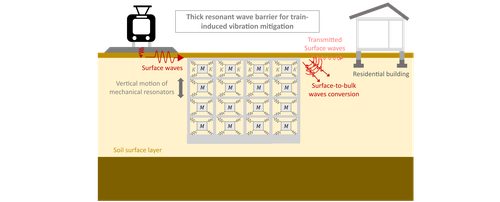Research background

Conceptual schematic of the proposed wave barrier
The expansion of railway networks in urban areas leads to discomfort for residents living near the railway lines due to vibrations and noise caused by passing trains. Train-induced ground vibrations result from the contact between train wheels and the tracks, propagating as elastic surface waves through the subsoil. These waves can reach the foundations of nearby buildings and travel through them. The characteristics of these surface waves vary depending on the type of train: high-speed trains produce significant vibrations when their speed approaches the ground wave speed, while freight trains, due to their weight and lower speed, create stronger and longer-reaching vibrations. Urban tramways, with relatively lower vibration amplitudes, can still affect nearby buildings. The intensity of ground vibrations can cause annoyance and concern among residents, particularly when the building's natural frequencies match the dominant train-induced surface wave frequencies, leading to higher vibration levels.
To reduce vibration levels, interventions can be performed on both the track and the transmission path. Current technologies for mitigating railway-induced vibrations include systems at the source (e.g., under sleeper pads, ballast mats, ground slabs, ballasted troughs, floating slab systems, booted sleepers, and vibration-isolating rail fasteners), at the receiver (e.g., elastic bearings in building foundations), and along the wave transmission path (e.g., deep stabilization methods, sheet piling, heavy masses along the track, soft and stiff barriers, and periodic inclusions). The cost and complexity of implementing source and receiver-based measures limit their practical application. However, measures along the wave transmission path, such as filled trenches or sheet pile wall barriers, which do not require modifications to existing infrastructure, provide efficient and cost-effective solutions for mitigating train vibrations.
The ELeMEnt project aims to develop an integrated framework to conceptualize, design, prototype, and test a Thick Resonant Wave Barrier with a tailorable operating frequency for train-induced vibration abatement. The wave barrier will exploit locally resonant devices (i.e., an array of mass-spring resonators or resonant pillars) designed according to the principle of Locally Resonant Metamaterials with an optimal spatial arrangement to reduce the overall barrier size.